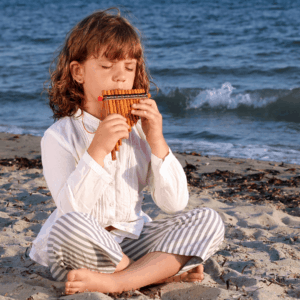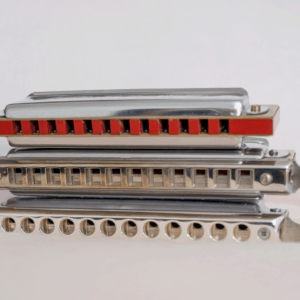
The didgeridoo is an Aboriginal wind instrument that dates back at least 1500 years. It was originally used for storytelling and teaching, but it is now used in a variety of musical forms, ranging from traditional to modern; jazz to rock. One of the most intriguing elements of this instrument is that the best didgeridoos are produced from eucalyptus trees and made by nature itself.
Here are 5 best didgeridoos for different needs.
| 1. Best didgeridoo for beginners – Hand fired Modern Didgeridoo in D key Hand crafted from synthetic and natural materials, lightweight, weatherproof and perfect for beginners. | Buy on Amazon | |
| | 2. Best affordable didgeridoo – Meinl Percussion DDG-BR 47 A great value didgeridoo made from bamboo and hand painted with a native design. | Buy on Amazon |
| | 3. Best travel didgeridoo – Spiral Shaped Didgeridoo SOLID MAHOGANY Wood This didgeridoo is constructed from an uncut and unbonded Mahogany tree and is of excellent quality. | Buy on Amazon |
| | 4. Best slide didgeridoo – X8 Drums X8-DIDG-SLD Slide Didgeridoo A fiberglass didgeridoo with a hand painted tropical design and a changeable pitch. | Buy on Amazon |
| | 5. Best professional didgeridoo – Handmade Didgeridoo Eucalyptus This handmade didgeridoo comes in a variety of shapes and keys and is made from the Yellow Box Eucalyptus tree. | Buy on Amazon |
| 6. Best didgeridoo book for self-learning – “Learn to play the didge” by Ed Drudy This book contains everything you need to know about playing the didgeridoo | Buy on Amazon |
5 Best didgeridoo reviewed
Best didgeridoo for beginners – Hand fired Modern Didgeridoo in Db key
This is the didgeridoo to get if you’re new to the instrument. It’s made of both synthetic (polymer tube) and natural materials (jute and beeswax). Each one is one-of-a-kind because they are not mass-produced but rather handcrafted one at a time, then twisted, sculpted, and curved to resemble wood and make each one special. Fire etched Tree Bark Look with a modern flair is the color of this didgeridoo. It’s made to withstand cold and heat, and the material won’t fracture or warp, making it ideal for beginners.
The resonant key is Db, resulting in a sound with highly bright overtones and deep drones, ideal for a beginner learner who is just getting started with this unique instrument. The mouthpiece is dipped in dark, raw bee’s wax, which aids in the formation of a seal between the molded playing end and your buzzing lips, resulting in a better drone sound. According to World Percussion USA, each instrument is individually examined to ensure a decent sound. This handcrafted instrument is ideal for determining whether the didgeridoo is the ideal instrument for you.
With only a little practice, any player should be able to get some good tones on this didgeridoo.
Pros
- Made of materials that aren’t easily damaged
- Individually tested
- Budget friendly
Cons
- Can’t be carved
- Not made for professional use
Best affordable didgeridoo – Meinl Percussion DDG-BR 47
With a weight of only 2.2 pounds and a length of 47 inches, this instrument is not only convenient to transport but also quite economical. It’s built out of a bamboo shell and tuned in the key od D#.
The bamboo shell design produces a distinct drone note effect with harmonic overtones, making it simple to achieve the ideal native Australian sound. Menl didgeridoos sound impressive enough on their own, but they’re also simple to play and a great option to have in a home or studio, whether you’re just getting started and want to experiment with different sounds. You can easily practice circular breathing or meditation with this instrument, whether you’re just getting started or you’re a seasoned pro.
With a hand painted dot pattern this didgeridoo has creative hand painted accents over a brown finish to mimic traditional native Australian artwork, the hand painted artistry ensures that no two didgeridoos are alike, making them one of a kind. The didgeridoo has a fantastic soothing, meditative effect when played, and it’s also an excellent instrument for learning circular breathing techniques.
The most common complaint about this instrument is that the bamboo shell is not weather resistant, fractures quickly, and requires extra care to keep it in good working order.
Pros
- Great sound for studio recording
- Affordable
- Hand painted native Australian artwork
Cons
- Cracks easily because of the material
Best travel Didgeridoo – Spiral Shaped Didgeridoo Solid Mahogany wood
This original Jive Brand Spiral Didgeridoo is a compact replica of a full-length didgeridoo with a rounded snake-like internal airflow pattern, making it a perfect travel companion, weighing only 1.67 pounds. This didge is 12″ long by 12″ wide and available in two shapes: S shaped and Spiral. It has handcrafted tribal designs that are one-of-a-kind for each item. This instrument is composed of uncut and unbonded Mahogany wood, and it has a unique resonance that produces a deep, resonating tone that is excellent for any musician. The resonant key of this instrument is F.
It is important to be aware that it has a learning curve, since it is smaller than many players assume. The mouthpiece, in particular, is quite tiny, and it took some practice to get a constant drone out of it. This didgeridoo does not come with a beeswax mouthpiece, which I recommend using to make it easier to play. However, many commercially available mouthpieces are way too large for it. A homemade one is preferable.
If you choose this instrument, be mindful that you may receive either a plain or a painted piece, depending on Jive stock inventory.
Pros
- Great for travel
- Made of Mahogany wood and is therefore of high quality.
- Lightweight
Cons
- No beeswax mouthpiece with it
Best slide didgeridoo – X8 Drums X8-DIDG-SLD Slide Didgeridoo
A slider didgeridoo is a combined didgeridoo and trombone instrument. It’s a seriously built and refined piece of acoustic technology that adds a whole new dimension and variety to playing the didgeridoo, despite its modest appearance. Fiberglass and polyvinyl chloride are used to construct it (PVC). The PVC (patent) X8 Drums Slide Didgeridoo’s fiberglass bell adds durability and a resonant sound.
The advantage is that you may fine tune your pitch by extending or reducing the top chamber and changing the key (C/C#/D/D#/E/F/F#/G/G# is the musical range from low to high) and that the keys are visible attached, so you won’t have any problems or troubles.
The instrument is 36 inches long when compressed and 61.5 inches long when expanded, weighs 2.5 pounds, and is suitable for people who perform on stage and play modern music. The entire instrument is beautifully painted in a traditional motif.
Pros
- You can change the pitch
- Great for performing on stage
- Hard to crack
Cons
- Made from synthetic materials
- It’s not hand carved
Best professional didgeridoo – Handmade Didgeridoo Eucalyptus
Terre is a company established in the United States that specializes in ethnic and natural sound instruments from all over the world.
This didgeridoo made of eucalyptus is one of the best for professional use. It comes in a number of designs (50, 55 and 59 inches). Because of its bulk, acoustic properties, and stability, this wood is ideal for Didgeridoos.It has a linseed oil finish on the interior and outside to keep it from breaking. The didgeridoo weighs between 6 and 8 pounds, it’s manual made, so each one is slightly different. You can also get a painted one, which is made from the tree’s root or the top. It’s also well-tuned, creating a swift and strong counter-pressure for optimal enjoyment when playing, and it’s made of yellow box eucalyptus.
It is available in a variety of keys, and you should contact the manufacturer to get the one you desire.
Pros
- You can choose the size and the key you want.
- Made from Eucalyptus tree
Cons
- Weighs between 6 and 8 pounds
Best didgeridoo book for self-learning – “Learn to play the didge” by Ed Drudy
If you want to learn how to play the didgeridoo, I recommend Ed’s book. The didgeridoo is an instrument that may be studied in its entirety on its own. There are five lesson plans included, as well as a history of how the didgeridoo was ‘discovered’ by the outside world, a chapter on using the didgeridoo to treat sleep apnea, and a glossary of terms used by didgeridoo players all over the world. It’s perfect for anyone who wants to launch a series of classes in their community, whether they’re a beginner or an expert.
Best Didgeridoo Buying Guide
What is a Didgeridoo?
Musicologists identify it as an aerophone, which is sometimes referred to as a natural wooden trumpet or “drone pipe.”
In reality, both musicologists and ethnomusicologists have researched the didgeridoo extensively. A didgeridoo is typically cylindrical or conical in design, and can range in length from 1 m (3.3 ft) to 3 m (9.8 ft), with the majority of instruments measuring around 1.2 m. (3.9 ft). In general, the lower the pitch or key of the instrument, the longer it is. Traditional Aboriginal players tend to play in keys ranging from D to F.
What’s the History Of The Didgeridoo?
The didgeridoo is a wind instrument played by Indigenous Australians (also known as aborigines) in northern Australia.Though the didgeridoo is frequently said to be the world’s oldest wind instrument, there are no reputable sources establishing its exact age.
According to archeological examinations of rock art in northern Australia, the didgeridoo has been used by Aboriginal people in the Kakadu region of the Northern Territory for nearly 1500 years.
As a result, the didgeridoo is a tribute to humanity’s long-standing innovation and musical ability
What Are the Benefits of Learning to Play Didgeridoos?
Playing the didgeridoo has been shown to improve physical wellness. While playing the didgeridoo should never be strenuous, the effort required to circular breathe while maintaining pulsating rhythms is sufficient to get the blood moving. As a result, didgeridoo playing for a long time can be an excellent low-impact cardiovascular workout.
The capacity and efficiency of the lungs can be enhanced, and the revitalizing effects of circular breathing can be quite beneficial. Anyone may feel the energy boost and revitalisation that comes with ten or twenty minutes of playing, but it is most obvious when the player is weary or lethargic.
The muscles in the upper airway of the respiratory system are strengthened by practicing this instrument, which reduces the likelihood of them collapsing while sleeping and thus aids in the treatment of sleep apnea (a common disorder characterized by potentially dangerous pauses in breathing while sleeping) and snoring.
What’s The Best Wood For Didgeridoo?
The type of wood used to make the didgeridoo has a significant impact on the sound quality. For professional performance and recording Eucalyptus is the ideal wood. For beginners and those on a tight budget, the PVC one may be a good choice because it requires less care and is more affordable.
There are many different types of didgeridoos available currently, ranging from modern to traditional. Authentic Aboriginal didgeridoos are made from hardwoods, particularly the several eucalyptus species unique to the region, among traditionally-oriented communities in northern Australia. Instead, a native bamboo or mahogany tree is sometimes used. The main trunk of the tree is usually chosen, but a large branch can also be used. Even if the main trunk is cut down near to the ground, the tree will rejuvenate as eucalyptus trees sprout again.
PVC piping can also be used to make less authentic didgeridoos. These typically have an inside diameter of 3.81 centimeters (1.50 in) to 5.08 centimeters (2.00 in) and a length that corresponds to the desired key. The mouthpiece can be fashioned of beeswax or a couple of thicknesses of duct tape. A mouthpiece can alternatively be made out of an adequately sized rubber stopper with a hole cut into it.
What Is The Distinction Between Different Keys?
Didgeridoos are available in a variety of keys or notes; some are in high keys, while others are in extremely low keys, and the rest are somewhere in between. Experienced players can play a wide range of keys, and it often depends on the player’s personal preference, but beginners should stick to the middle keys.
A, A#, B (lower keys)
C, C# ,D, D#,E (middle keys)
F, F#, G, G# (higher keys)
The middle key didgeridoos can be played at a variety of speeds due to the lower lip control required to play them and their adaptability as a mid-range instrument, which is useful if you only have one didgeridoo to practice with.
Lower keys, like A and B, are ideal for slower, more meditative, and relaxed playing, as well as generating atmospheric music. To play these instruments successfully, though, you’ll need more air and effort. Lower keys on the mouthpiece are often more sensitive, requiring greater lip control.Fast, percussive, rhythmic styles of play are best suited to higher keys like F and G. They usually have less sensitivity on the mouthpiece, which makes them easier to play. These instruments, on the other hand, necessitate more lip control, frequently in the shape of tighter lips, and a player’s technique and timing must be more precise.
Summary
The didgeridoo is indeed an instrument that is broadly used. It’s used in a variety of musical forms, and its popularity is growing by the day. You can’t go wrong by getting it, whether you want it for the health benefits that come with practicing it, for performing on stage, or just for fun.
The uniqueness of this instrument is well known, and the sound is strongly influenced by the key and the wood used in its creation.
The Handmade Eucalyptus didgeridoo by Terre is our top pick because of the high quality materials used, the essential options available, and the professional artwork on it.
Last update on 2023-04-27 / Affiliate links / Images from Amazon Product Advertising API





